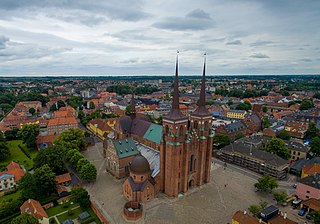
Demographic features of the population of Denmark proper, part of the Danish Realm, include ethnicity, education level, health of the populace, economic status, religious affiliations, and other aspects.

The economy of Denmark is a modern high-income and highly developed mixed economy. The economy of Denmark is dominated by the service sector with 80% of all jobs, whereas about 11% of all employees work in manufacturing and 2% in agriculture. The nominal gross national income per capita was the ninth-highest in the world at $68,827 in 2023.

Christianity is the largest religion in Denmark. As of 2022, 72.5% of the population of Denmark were registered members of the Church of Denmark, the officially established church, which is Protestant in classification and Lutheran in orientation.

The Somali diaspora or Qurbajoogta refers to Somalis who were born in Greater Somalia and reside in areas of the world that they were not born in. The civil war in Somalia greatly increased the size of the Somali diaspora, as many Somalis moved from Greater Somalia primarily to Europe, North America, Southern Africa and Australia. There are also small Somali populations in other pockets of Europe and Asia. The UN estimates that in 2015, approximately 2 million people from Somalia were living outside of the country's borders.
Danish Pakistanis form the country's fifth largest community of migrants and descendants from a non-Western country, with 14,379 migrants and 11,282 locally born people of Pakistani descent as of 1 January 2019 according to the latest figures published by the government of Denmark.
Lily Broberg was a Danish stage and film actress.

Ishøj is a Danish town with a population of 21,269. It is situated in the Region Hovedstaden, and is the seat of the Ishøj Municipality.
In 2017, Norway's immigrant population consisted of 883,751 people, making up 16.8% of the country's total population. Of this number, 724,987 are foreign-born, while 158,764 are Norwegian-born with foreign-born parents. The ten most common countries of origin of immigrants residing in Norway are Poland (97,197), Lithuania (37,638), Sweden (36,315), Somalia (28,696), Germany (24,601), Iraq (22,493), Syria (20,823), Philippines (20,537), Pakistan (19,973) and Eritrea (19,957). The immigrant population comprises people from a total of 221 countries and autonomous regions, but 25% of the immigrants are from one of four migrant groups: Polish, Lithuanians, Swedes and Somalis.
Iraqis in Denmark consist of both immigrants from Iraq to Denmark and their descendants, and may hold either Iraqi or Danish citizenship.

Crime in Norway is countered by Norway's law enforcement agencies.

Poles in Norway are citizens and residents of Norway who are of Polish descent. They are the biggest immigrant group in Norway.
Denmark has seen an increase in immigration over the past 30 years, with a large part of the immigrants originating from non-Western countries. As of 2014, more than 8 percent of the population of Denmark consists of immigrants. As of Q2 of 2022, the population of immigrants is 652,495, excluding Danish born descendants of immigrants to Denmark. This shift in demographics has posed challenges to the nation as it attempts to address cultural and religious differences, labour shortages, employment gaps, education of immigrants and their descendants, spatial segregation, crime rates and language abilities.
Syrians in Denmark are citizens and residents of Denmark who are of Syrian descent.
Somalis in Denmark are citizens and residents of Denmark who are of Somali descent.
Eritreans in Norway are citizens and residents of Norway who are of Eritrean descent. Most have a background as asylum seekers that have fled Isaias Afwerkis regime.
Somalis in Norway are citizens and residents of Norway who are of Somali descent. They are the biggest African migration group in Norway. 36.5% of Somalis in Norway live in the capital Oslo. Almost all Somali in Norway have come to Norway as refugees from the Somali Civil War. In 2016, Somalis were the largest non-European migrant group in Norway.
Moroccans in Norway are citizens and residents of Norway who are of Moroccan descent.
Moroccans in Denmark are citizens and residents of Denmark who are of Moroccan descent.

"Vulnerable residential area" is an official term for a social housing district in Denmark which fulfils certain statistical criteria of relatively low employment/school attendance, relatively low income, a relatively low educational level and/or relatively many convicted inhabitants. If more than 50% of the residents in a vulnerable area are non-Western immigrants and their descendants, the area is additionally designated a "parallel society". The Danish government has published an official list of vulnerable residential areas annually since 2010, with changes in the definition and/or terminology in 2013, 2018 and 2021. During the period 2010-2021, the term "ghetto" was used officially to designate some or all of the vulnerable areas, but the term was considered controversial and removed in 2021.
The COVID-19 pandemic in Denmark was a part of the ongoing worldwide pandemic of coronavirus disease 2019 (COVID-19) caused by severe acute respiratory syndrome coronavirus 2 (SARS-CoV-2). The virus was first confirmed to have spread to Denmark on 27 February 2020.









